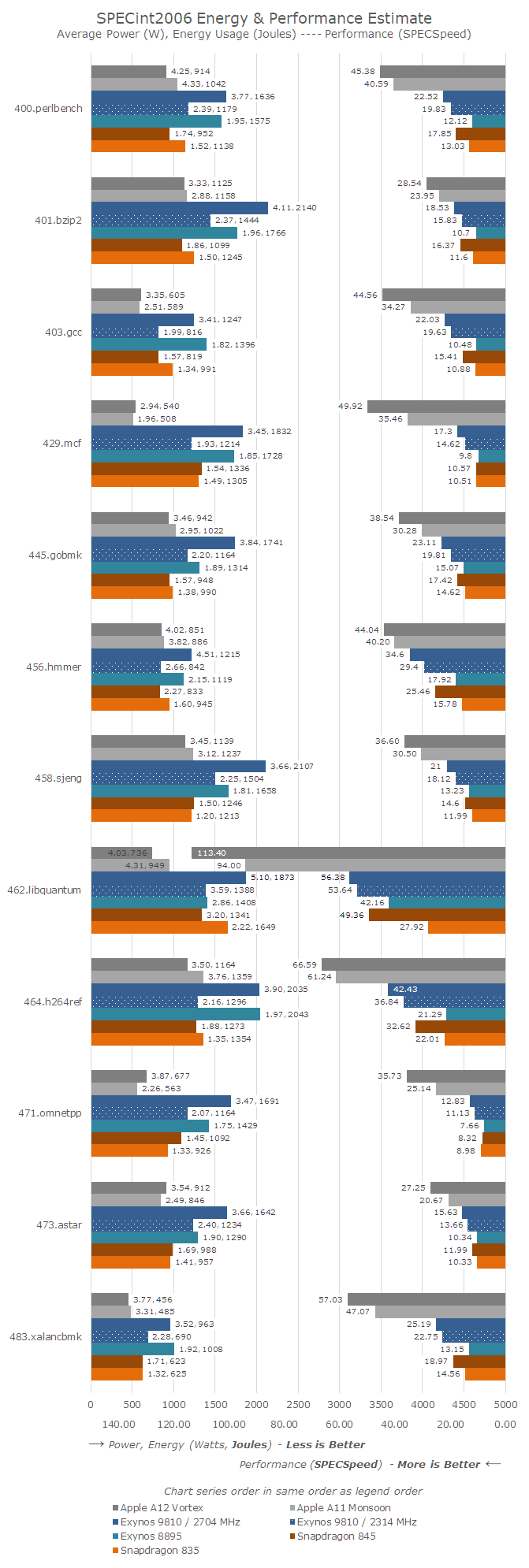https://www.anandtech.com/show/13392/the-iphone-xs-xs-max-review-unveiling-the-silicon-secrets/4

The performance measurement was run in a synthetic environment (read: bench fan cooling the phones) where we assured thermals wouldn’t be an issue for the 1-2 hours it takes to complete a full suite run.
---
Overall the new A12 Vortex cores and the architectural improvements on the SoC’s memory subsystem give Apple’s new piece of silicon a much higher performance advantage than Apple’s marketing materials promote. The contrast to the best Android SoCs have to offer is extremely stark – both in terms of performance as well as in power efficiency. Apple’s SoCs have better energy efficiency than all recent Android SoCs while having a nearly 2x performance advantage. I wouldn’t be surprised that if we were to normalise for energy used, Apple would have a 3x performance efficiency lead.
This also gives us a great piece of context for Samsung’s M3 core, which was released this year: the argument that higher power consumption brings higher performance only makes sense when the total energy is kept within check. Here the Exynos 9810 uses twice the energy over last year’s A11 – at a 55% performance deficit.
Meanwhile Arm’s Cortex A76 is scheduled to arrive inside the Kirin 980 as part of the Huawei Mate 20 in just a couple of weeks – and I’ll be making sure we’re giving the new flagship a proper examination and placing among current SoCs in our performance and efficiency graph.
What is quite astonishing, is just how close Apple’s A11 and A12 are to current desktop CPUs. I haven’t had the opportunity to run things in a more comparable manner, but taking our server editor, Johan De Gelas’ recent figures from earlier this summer, we see that the A12 outperforms a Skylake CPU. Of course there’s compiler considerations and various frequency concerns to take into account, but still we’re now talking about very small margins until Apple’s mobile SoCs outperform the fastest desktop CPUs in terms of ST performance. It will be interesting to get more accurate figures on this topic later on in the coming months.

The performance measurement was run in a synthetic environment (read: bench fan cooling the phones) where we assured thermals wouldn’t be an issue for the 1-2 hours it takes to complete a full suite run.
---
Overall the new A12 Vortex cores and the architectural improvements on the SoC’s memory subsystem give Apple’s new piece of silicon a much higher performance advantage than Apple’s marketing materials promote. The contrast to the best Android SoCs have to offer is extremely stark – both in terms of performance as well as in power efficiency. Apple’s SoCs have better energy efficiency than all recent Android SoCs while having a nearly 2x performance advantage. I wouldn’t be surprised that if we were to normalise for energy used, Apple would have a 3x performance efficiency lead.
This also gives us a great piece of context for Samsung’s M3 core, which was released this year: the argument that higher power consumption brings higher performance only makes sense when the total energy is kept within check. Here the Exynos 9810 uses twice the energy over last year’s A11 – at a 55% performance deficit.
Meanwhile Arm’s Cortex A76 is scheduled to arrive inside the Kirin 980 as part of the Huawei Mate 20 in just a couple of weeks – and I’ll be making sure we’re giving the new flagship a proper examination and placing among current SoCs in our performance and efficiency graph.
What is quite astonishing, is just how close Apple’s A11 and A12 are to current desktop CPUs. I haven’t had the opportunity to run things in a more comparable manner, but taking our server editor, Johan De Gelas’ recent figures from earlier this summer, we see that the A12 outperforms a Skylake CPU. Of course there’s compiler considerations and various frequency concerns to take into account, but still we’re now talking about very small margins until Apple’s mobile SoCs outperform the fastest desktop CPUs in terms of ST performance. It will be interesting to get more accurate figures on this topic later on in the coming months.

